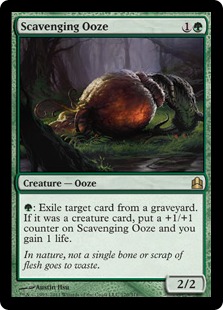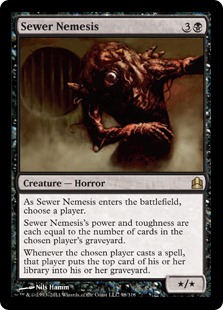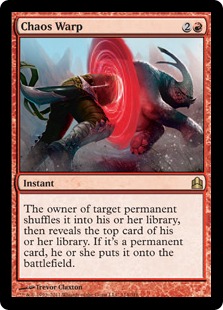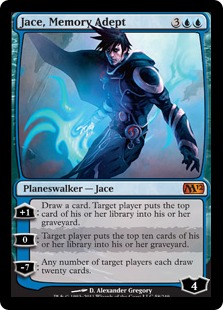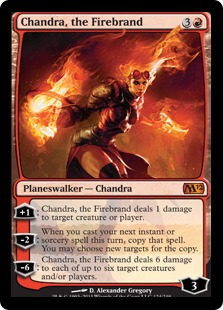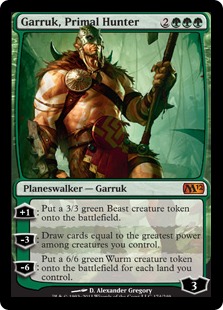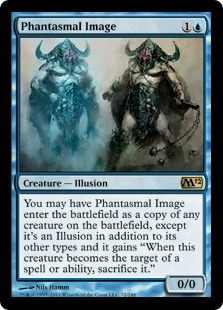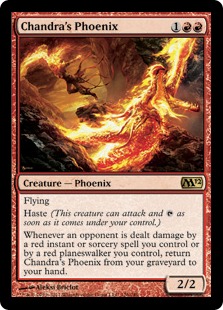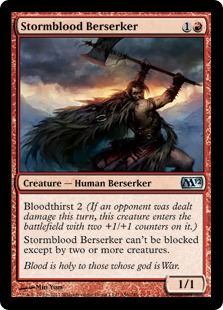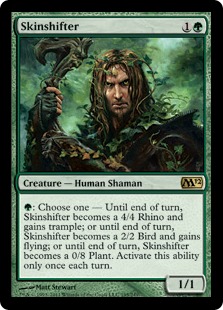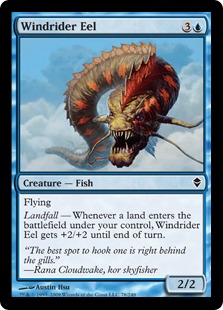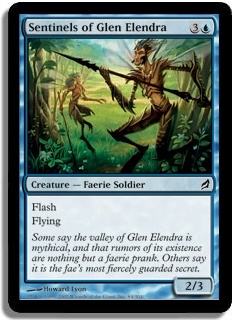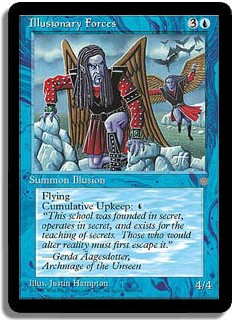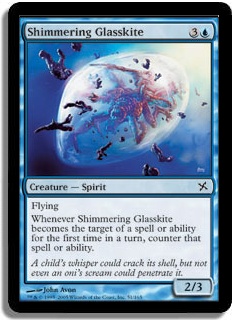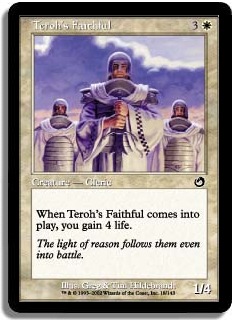With M12 coming out, it’s time to consider the set in the context of cube. Since I didn’t do a review for Commander, I figured that I’d add that to
this review as well. I’ll first be covering cards that I’m adding to my cube, cards that I think are solid performers for all but the tightest cubes.
Commander:
Scavenging Ooze:
My first article for Star City Games was about “hoser” cards in cube, and it’s appropriate that it’s the first card that I include in this review. It’s a good idea, when considering cards for cube, to look at similar
cards for comparison and upon initial glance, Scavenging Ooze may look like one of the narrow graveyard hosers like Withered Wretch and Relic of Progenitus. Both of these cards suffer in cube because while they’re serviceable cards that can be used in the final 40 of a cube deck (as Relic
of Progenitus can be cycled away for a card, and Withered Wretch is a BB for a 2/2 Zombie, at worst), most decks won’t want to put those cards in their
final 40s unless the draft went badly, as both cards don’t do enough when the opponent isn’t relying on graveyard shenanigans.
However, there are pitfalls when using comparisons between existing cards. Scavenging Ooze isn’t a narrow graveyard hoser like the aforementioned
cards. It’s always nice to have answers to a lot of various threats in cube since a well-balanced cube supports a lot of different paths to victory.
Cards like Wickerbough Elder and Skinrender have been great in cube for that very reason. Scavenging Ooze does a stellar job of attacking opposing
graveyards (like Withered Wretch), but its effectiveness isn’t reliant on the opponent’s graveyard plans; it’s solid in just about any matchup. Â
Cards like Bonehoard and Reveillark have shown us that cards quickly go to the graveyard in cube, especially when decks reliant on a lot of creatures
face off against each other. Scavenging Ooze preys on this facet of cube with its pseudo-level up ability; much like traditional levelers like Kargan
Dragonlord and Student of Warfare, Ooze’s ability to scale makes it solid in both the early and late game. I’ve found that even though Scavenging
Ooze’s ability to grow is reliant on creatures in a graveyard, it isn’t terribly difficult to get it to sizes like 6/6, 7/7, or 8/8 in a cube game. Its
life gain is also really useful against opposing aggressive decks that have lots of dead creatures (through them dying or killing yours through
removal/burn).
Overall, I consider it a staple, as it’ll be a welcome addition to all green decks, from aggressive green decks to ramp-based green decks.
Sewer Nemesis:
Another card that preys on graveyards and things going to the graveyard in cube is Sewer Nemesis. While Scavenging Ooze’s closest analogue is Withered
Wretch, Sewer Nemesis’s closest analogues are Plague Sliver and Juzam Djinn—both four-mana black creatures mainly used for their large size at a cheap
cost. As I mentioned in my last article, there’s a limit to the cards that can be used at each mana cost, and four is a particularly interesting one,
as it’s typically turn 3 for control decks (that accelerate with either green mana acceleration, a Signet, or another type of mana accelerant such as a
Mind Stone or Everflowing Chalice) and is the top end of the mana curve for aggressive decks, as those decks typically don’t want the game to last for
much longer than that. Combine this with the insane competition in black’s four-mana slot (Nekrataal, Skinrender, the 2BB 5/5s, Abyssal Persecutor),
and room is very tight at that slot.
The main issue with Sewer Nemesis is its inconsistency in size. Lots of things go to the graveyard in cube, true, but the degree of how many is
uncertain. Inconsistency doesn’t make a bad cube card, and you can influence the rate of cards going to the graveyard by playing a lot of cards that
make cards go to the graveyard—decks with lots of fetchlands, removal/burn, discard, etc. The decks that will utilize Sewer Nemesis will be either
disruption-heavy black aggressive decks or midrange and control-based decks that seek to drop Sewer Nemesis in the late game as a huge finisher. I’ve
not been able to see how big Sewer Nemesis has been on average, but I’ve been trying him in place of Plague Sliver to see which has more of a board
impact. In larger cubes such as those that are larger than 600 cards, Sewer Nemesis could be used alongside Plague Sliver and Juzam Djinn, but smaller
cubes have to ultimately choose between the four-mana attackers due to the limited slots available.
Chaos Warp:
Beast Within has been an interesting cube card—typically used as a failsafe button against difficult to deal with permanents, or at least “the ones
that matter” a la Carlos Romao’s school of thought when he won by dominating Psychatog–Upheaval mirrors in the 2002 World Championships (by focusing on
those two spells) and how
Mike Flores found how to best attack the Cruel Control mirror a few years ago using that same school of thought. Chaos Warp is a riff on Beast Within in that it is a failsafe button against dangerous cards and is a flexible card that can deal with Jace, the Mind
Sculptor, Moat, and Smokestack alike, albeit with more variance than the beastmaker.
Many cube decks use around 16 or 17 lands with an occasional instant or sorcery (although this wildly varies, as U/R Counterburn is going to have a lot
more Chaos Warp blanks than something like R/G aggro). Typically, Chaos Warp turns an offending permanent into either a land or, well, nothing. Of
course, that doesn’t mean that a dangerous permanent won’t enter from the library into play, but even when that happens, the downgrade is still a
positive overall benefit.
Take, for example, when my R/G aggro deck Chaos Warped an opposing Jace, Memory Adept in a U/W control deck. It turned into a Reveillark, which was
certainly worse than a 3/3 Beast, but at least I wasn’t staring down a lethal planeswalker anymore. Just be sure to not be too results-oriented when
you get blown out by it, because for the most part, it’s a very solid removal spell that’s welcomed in cubes of all sizes.
Edric, Spymaster of Trest:
U/G is one of the more interesting color combinations in cube; unlike U/R, U/W, and U/B, which are typically represented by control decks, U/G is
typically represented by tempo decks or ramp-style decks. Edric, Spymaster of Trest fits the tempo decks like a glove, as it turns your creatures into
Scroll Thieves. Many creatures in the U/G decks typically provide value by doing something when they come into play. Uktabi Orangutan kills an
artifact; Venser, Shaper Savant bounces a spell; and Edric provides more card advantage on top of that. However, Edric is very solid when it’s cast as
a Coastal Piracy on legs with creatures ready to attack. A turn 3 Edric that follows a turn 1 Jungle Lion and a turn 2 Looter il-Kor is a huge beating,
and the more support given to decks that have consistent starts like this, the better. He’s a fourth to the U/G stalwarts like Simic Sky Swallower,
Mystic Snake, and Trygon Predator, but if your cube has room for another U/G card behind those four, he should definitely be used.
M12:
Jace, Memory Adept:
Jace, Memory Adept may look downright terrible when compared to the Mind Sculptor (especially since the 2UU guy just got banned in Standard), but
Memory Adept is still very solid in cube. Straight-up mill effects aren’t very good in cube unless they’re:
1)Â Â Able to mill an opponent quickly enough for it to be a valid path to victory on its own as well
2)Â Â Do something relevant enough so that it’s good enough without the milling, like Oona, Queen of the Fae and Sword of Body and Mind.
Unlike the previous iterations of Jace whose main strengths were in burying the opponent in card advantage, Jace, Memory Adept’s primary role will
likely be in killing opposing players very fast through his mill ability. Planeswalkers like Venser, the Sojourner and Liliana Vess can have a big
effect when they’re not impacting the board, but Jace, Memory Adept is able to use that ability to win the game very quickly, sometimes out of nowhere.
I’ve seen Jace, Memory Adept slam the door on players in a couple of turns when the opponent didn’t have creatures to attack Jace or didn’t draw the
planeswalker removal to kill him. His draw ability is also great. I’ve found that it’s typically used when he isn’t protected very well and you need to
draw into something. He’s going to be really solid in control and midrange mirrors, as those decks may not be able to answer a Jace very quickly (and
for that reason, he won’t be as good against aggro decks). Overall, he’s worse than his Beleren and Mind Sculptor versions, but he’ll definitely be a
welcome addition to all cubes.
Chandra, the Firebrand:
Chandra, the Firemind will be a welcome addition to cubes as a supplement to creature combat and red’s usual plan of winning through burn. In a way,
she acts like a super-pinger (like a Cunning Sparkmage in planeswalker form) with some added utility and flexibility. Much like pingers, she’ll combine
well with attacking (usually aggro) creatures on the offense. The ability to clone burn spells should aid in that goal.
Unlike Koth, which was mainly used in offensive decks, Chandra, the Firebrand will be more universally playable, as her -2 ability works well with the
many instants and sorceries in spell-based control decks like U/R Counterburn. Still, her home will be more often in red-based aggro decks, and her -2
ability works pretty well in those decks. I live for the day that Chandra clones a Plow Under!
It’s clichéd to say that a lot of the best planeswalkers are so because they protect themselves (Jace, the Mind Sculptor, Elspeth, Knight-Errant), and
unfortunately, Chandra, the Firebrand doesn’t protect herself very well against creatures with two toughness or higher, which may hurt her playability and may end up leaving her on the lower end of the cube planeswalkers.
It may be an easy change to replace Chandra Nalaar with Chandra, the Firebrand, but I don’t see that as being the right move unless you’re
intentionally limiting the number of planeswalkers, as both are solid cards that perform tasks very well. Chandra Nalaar is awesome at dealing with
midrange creatures like Dragons and Titans or a few small ones (I’ve heard her nicknamed Flametongue Planeswalker), while Chandra, the Firebrand is a
more offensive creature booster with some nice synergies. Chandra, the Firebrand doesn’t obsolete Nalaar, so I think replacing Nalaar with Firebrand is
a mistake.
Still, she’s definitely good enough for many cubes.
Garruk, Primal Hunter:
Cube master Kenny Mayer said that Garruk, Primal Hunter’s power level is comparable to something like Gideon Jura as a solid, universally playable
planeswalker that aggressive, midrange and control decks will all want to play. I can get behind that analogy.
Garruk, Primal Hunter’s ability to increase his loyalty, while protecting himself, isn’t seen very often outside of Elspeth, Knight-Errant. The 3/3s
that he pumps out can get out of hand very quickly (especially if he lives for a few turns). His draw ability is something that I don’t think will be
used as often (at least, not without making a Beast first), but midrange decks with lots of large creatures shouldn’t be opposed to using that ability.
His cost is unfortunately pretty awkward, but green is the best color to hit the triple-cost by turn 5 or 6. I’ve found it isn’t very hard to achieve.
A lot of people are replacing Harmonize with Garruk, Primal Hunter, and even though I don’t think Garruk’s draw ability will be used as much as his
Beast-churning ability, I think that’s a fair trade to do, and I jumped on that bandwagon myself. I’m not sure where I’d rank him in the grand scheme
of five-mana green spells, as the color has varied ones from Plow Under to Acidic Slime to Kodama of the North Tree, but I’d say he’s pretty high in
that ranking (below Plow Under, Thornling, and Deranged Hermit, if I absolutely had to choose) and should be causing headaches for people in cube for a
long time.
Phantasmal Image:
There hasn’t been Clone at two mana since Dance of Many, and that card was just terrible—especially in cube. It was only just recently with New
Phyrexia that we got a three-mana Clone with Phyrexian Metamorph! Through Phyrexian Metamorph, we’ve learned that the reduction of one makes a world of
difference (which shouldn’t be a huge shock; Isamaru is awesome at W, but Silvercoat Lion is terrible at 1W) since, let’s be honest, Phyrexian
Metamorph was often copying creatures rather than artifacts (although that part was a nice addition).Â
If you played with Makeshift Mannequin, you’ll remember how most of the time, it reanimated things that had “enter the battlefield” triggers like
Mulldrifter and Grave Titan so that even if the creature died from a spell or effect, you got value out of your 3B mana.
Many times, Phantasmal Image will be used in that same way—cloning things for value. There aren’t too many cards in cube that would kill the Illusion
that aren’t straight-up 1-for-1s like Terror/Doom Blade (well, outside of red’s spells like Arc Lightning, Arc Trail, etc.). There aren’t a lot of
repeatable effects (although having your Illusion die to an Elspeth, Knight-Errant can be awkward!). Phantasmal Image is also the cheapest way for blue
to destroy opposing legends; even Doom Blade can’t kill a Thrun, the Last Troll! I had an opponent copy a Mulldrifter with Phantasmal Image, and even
though I had the ability to kill the Illusion (through a Jace, the Mind Sculptor bounce), the opponent still got a lot of value for 1U.
There’s also the use for it to copy creatures with shroud or hexproof, as those abilities counteract the drawback of Phantasmal Image (copy my Simic
Sky Swallower for two? Sure!).
You’ve also probably ridden a “big dumb” creature reanimated by Makeshift Mannequin to victory, and sometimes, that’s how the victory plays itself out,
but I haven’t seen that happen that often. Typically it just copies something for value, and for 1U, I’m more than happy with that, and I’m very happy
to include it in my cube for that reason.
Chandra’s Phoenix:
Sometimes, all you need is a simple upgrade to turn something solid into cubeworthiness.
Take Burst Lightning.
Burst Lightning typically gets used as a Shock, but its ability to turn into a Lightning Blast (that costs an additional mana) makes it into a cube
staple due to the added value.
Chandra’s Phoenix turned Skyknight Legionnaire, an already solid card but one that doesn’t quite have enough to break through R/W’s competitive
barrier, into a mono-red card. Red’s three-drop creatures isn’t the deepest of pools (although its spells are typically quite deep), and giving red
decks a creature with reach at this vital spot in the curve is always welcome.
Chandra’s Phoenix will get better in decks that have a lot of spells that have value outside of straight burn—spells that damage an opponent while
doing something else like Molten Rain, Earthquake, and Arc Trail—as throwing burn at an opponent’s face typically isn’t the best path to victory unless
it’s used to burn the opponent out for victory. Even when that’s the path to victory, Chandra’s Phoenix helps with that path as well.
Stormblood Berserker:
Heezy Street, the R/G aggressive breakout deck of Pro Tour Honolulu 2006, utilized Scab-Clan Mauler by providing the potential 3/3 with eleven maindeck one-drops,
making it so that the Mauler was typically a 3/3. Red aggressive decks in cube shouldn’t have a problem similarly supporting Stormblood Berserker, as
aggressive decks seek to use a lot of cheap creatures to start the beats on turn 2 consistently. It isn’t BCSM to consider these starts
to be the norm, as these are the starts that your red aggressive decks should have (and if there isn’t the support to make those starts happen
consistently, give red that support!).
Even as a mere 1/1 that can’t be blocked by a solitary creature, the ability is still solid, as it makes him very difficult to block—especially against
control decks that rely on a single wall or finisher to stall the ground. Because of his strong stats and innate support for him in cubes that support
aggressive archetypes, he’ll be a solid performer in cube.
Skinshifter:
We’ve seen strong competition in green aggressive creatures, and ones that provide versatility are nice. Skinshifter will probably get used as a 4/4
with a G upkeep, although its 2/2 flying and 0/8 abilities will have effective uses as well (against opposing planeswalkers or aggro decks,
respectively). I’ve heard comparisons to Putrid Leech, but there’s a world of difference between zero and one mana.
Granted, spending mana on him for a non-permanent effect is annoying (Scavenger Ooze’s ability giving +1/+1 counters is great for that very reason),
but at least in the aggressive decks, you’re hoping to win the game as soon as possible, so that the lost tempo doesn’t matter too much (since the
opponent should be dead). Unfortunately, lost mana is lost mana, which can be annoying in the early stages of the game.
Will the additional utility provided by Skinshifter’s abilities of turning into a 2/2 flier or a 0/8 Plant make him a staple? Probably not. But I think
he’s still going to be a solid creature, regardless.
The following are cards that I don’t really think are good enough for a majority of cubes. At least, cubes that aren’t huge.
Mind Unbound
The first thing to note is that Mind Unbound is really slow, as it offers no immediate card advantage, and you have to wait a while for the card
advantage to manifest. At a “finisher” mana cost like six, you need to do something very good at six mana (Upheaval or finishers like Sphinx of Jwar
Isle, Consecrated Sphinx, Keiga, and Wurmcoil Engine), especially if it’s causing you to tap out at sorcery speed. While Mind Unbound promises
long-term card advantage, cheaper spells (even ones like Deep Analysis) do it more quickly, cheaply, and more reliably. It can be nice if the game runs
very long, but it’s generally not worth using.
Gideon’s Avenger
Gideon’s Avenger is kind of like Taurean Mauler where you can think with Best-Case Scenario Mentality in mind and imagine a bunch of attacking
creatures attacking into it, making him huge, but ultimately in the hands of the opponent (much like Taurean Mauler). It’s also not very good against
midrange and control decks, as they won’t be attacking with the speed necessary to make Gideon’s Avenger a relevant threat. It’s just too clunky and
inefficient to be very good in cube.
Sphinx of Uthuun and Rune-Scarred Demon
Both of these seven-mana fliers are an arguable upgrade to the New Phyrexia Praetors in that they both give an immediate and powerful effect when cast,
but both just don’t do enough for their cost, and they don’t compare very well to other finishers of a similar cost—mainly the M11/M12 Titans. I’ve
said it enough times to sound like a broken record, but there’s room for so many finishers to make a well-balanced cube (as black control decks don’t
need a high amount of finishers), and both cards just don’t cut it in non-large cubes. Larger cubes should be able to run these cards due to the
increased slots, but the competition is just way too tight for these creatures.
Grand Abolisher
Much like with Inquisitor Exarch, I really wish that Grand Abolisher had another ability—first strike, lifelink, flying, etc. He’ll be a thorn in the
side of blue mages with some additional hate for decks that are reliant on end-of-turn shenanigans, but much like Teferi, Grand Abolisher doesn’t invalidate the non-counterspell cards. It just makes it so that the opponent has to play differently. This will result in some adjustment in
play and having to do things differently (the opponent can’t Char my Celestial Colonnade), which can definitely be annoying, but it isn’t the end of
the game.
It’s not a narrow hoser like Kor Firewalker, a card that’s excellent against its respective target, but it doesn’t quite do enough against other
archetypes. White aggro decks should be supported through using a lot of one- and two-mana white creatures (not just “I’m running Soltari Priest, Monk,
and Mother of Runes”), so using Grand Abolisher is good in theory, but even though you want to use a lot of two-drops in white, the competition is
still pretty stacked. For example, Leonin-Relic Warder has been a solid addition for cubes, as an aggro-supporting two-drop in white, but for every
Relic-Warder, there’s an Inquisitor Exarch that just doesn’t get into many cubes because of the limited space.
Jade Mage, Crimson Mage, Azure Mage
I want to like these Wizards. I really do. But they just felt like they didn’t quite do… enough.
Crimson Mage may be the best out of these, as red aggressive decks value their cheap creatures, and Crimson Mage turns up the clock on freshly cast
ones as well as acting as a 2/1 kicked Skitter of Lizards if need be. I just found that I never really wanted to cast Crimson Mage, in my red
aggressive decks. I typically wanted to cast my more efficient creatures ahead of this, as my curve was tight, and the impact that Crimson Mage
provided wasn’t quite enough. It may be one of those cards like the levelers where it’s optimal when you’re not naturally curving out, and that may be
seen in the future. Put me on “solid, but you don’t need to put this in your cube ASAP.”
Azure Mage is interesting because its closest analogue is Jushi Apprentice, yet I feel that both play very different roles. Azure Mage will be at its
best in blue-based attack decks (where cards like Edric, Spymaster of Trest will shine) whereas Jushi Apprentice performs best in blue-based control
decks that don’t want to attack unless it’s with a huge finisher. In theory, Azure Mage provides reach for these blue-based tempo decks like Dimir
Guildmage did (but making it so that you could hold counter/bounce mana up). I found that in reality, its draw ability was highly priced, but if you’re
looking for cards to enhance blue tempo/attack strategies, Azure Mage is a solid addition (especially since it has two power, which isn’t too easy to
find in blue).
Jade Mage is another card that just seems better in theory than in practice. I used to run Selesnya Guildmage, frequently for its ability to make
Saprolings, but its Saproling generator ability didn’t matter that often, as cubes don’t typically have long drawn-out game states outside of the
control/midrange mirror. I really want Jade Mage to be a “solid attacker in the early game, reach in the late game,” but it just doesn’t seem like it’s
really good at either.
That’s my main beef with these mages for rare cubes; they don’t seem to perform their respective tasks very well. Flexibility is great in cube, and
many cube staples fit that role, but these cards don’t seem to have their component parts to equal a great cube card. I’d try them if your cube is on
the larger side (600+), but competition is tight enough so that these mages don’t make the grade. In peasant cubes, however, these cards get better
from the lowered competition and should be a welcome addition.
I hope that this article has given you some insight into what M12 and Commander offers for your cube. I’ve decided to change the style of the review to
an unusual approximate ranking style. Let me know what you think in the comments, on my Twitter or blog (the latter two gratuitously linked below).
May all of your opening packs contain Sol Rings!
@UsmanTheRad
 on Twitter
My blog featuring my powered and pauper cube lists: http://idratherbecubing.wordpress.com
Cube podcast that I and Anthony Avitollo co-host: The Third Power
Bonus Section
In the next section, I’ll be covering cards from a pauper (only commons) and peasant (only commons and uncommon) perspective.
Pauper:
Pride Guardian:
When I saw Pride Guardian, I immediately compared it to Perimeter Captain; both are mainly defensive cards that provide breathing room to defensive
decks, albeit with a vulnerable 0/3 body. Red aggro is a powerful archetype in pauper cubes, and despite the fact that it’s cliché to say, it dies to a
lot of red’s removal. A card like Mountain Yeti looks like it should be a solid white AND red hoser from the mountainwalk, but its toughness of three
is a big liability against a color with bolts aplenty. Still, if the opponent doesn’t have the red removal (or black removal through cards like
Terror), he can stall the ground for a long time.
Whether you want this card in your pauper cube depends on if you feel a defensive-only tool is needed for white defensive decks, and that can differ
from cube to cube. As for me, I’m leaving it on the sidelines.
Benalish Veteran/Blood Ogre:
I’ve included both of these in a single point, as these are both, at least in theory, 3/3s for three. At least, that’s what you want them to be.
Blood Ogre may be the best out of these since red shouldn’t have a problem getting bloodthirst on turn 3 (just like with Stormblood Berserker), and a
3/3 first striker is VERY hard to take down in combat, as can be seen from landfalled Plated Geopedes and Porcelain Legionnaires. All of these
typically die from a removal spell or a huge gang-block of creatures. But is it better than other underutilized three-drop creatures like Hulking Ogre?
I think so.
Benalish Veteran similarly should be solid for white attack decks since, let’s be honest, it should always be a 3/3 attacker. Much like Benalish
Veteran, is it better than underutilized virtual 3/3s like Kitsune Blademaster and Ballynock Cohort? Due to its consistent high power on offense, it’s
better at that task. But does it provide more value to your overall cube than those two creatures? I think so.
Gorehorn Minotaurs:
As mentioned before, it shouldn’t be hard to trigger bloodthirst on turn 3 in aggressive red decks, as most of your creatures should be under that mana
cost. An interesting thing to note is that a 5/5 in the format is MASSIVE. There’s the risk/reward, as a vanilla 3/3 is meh at best, yet it’s almost
impossible to take down in combat. (Have you seen a Blastoderm die in combat in pauper? It doesn’t happen often, at least not without the cost of a lot
of creatures trading with it.) Due to the high potential reward, Gorehorn Minotaurs should fit well in pauper cubes.
Stave Off:
Pauper cubes just got Apostle’s Blessing in New Phyrexia. Stave Off shaves protection from artifacts off, but isn’t a huge loss since there aren’t many
in the format. Cubes with a lot of combat tricks may wish to trade Apostle’s Blessing for Stave Off due to the lack of life loss (at the cost of any
deck being able to use it), but smaller cubes probably won’t have the room for it, as Shelter’s a hard combat trick to compete with.
Arachnus Web:
There’s something to be said of uniqueness, and Arachnus Web offers an Arrest to green, a color that doesn’t typically have a way to lock down
creatures. The four-power trigger isn’t likely going to matter very much, as many of the creatures in commons are three power or less (save huge
finishers like Ulamog’s Crusher, Errant Ephemeron, and Equipment that breaks the web like Vulshok Morningstar and Opaline Bracers), but it’s more the
lack of efficiency of the effect that makes me iffy on it. I’ve never been a fan of removal that costs more than three mana and doesn’t provide an
additional benefit (which is why I don’t use Arrest or Rend Flesh in my commons cube). It’s a unique effect for the color, but I don’t think that makes
a suboptimal card suddenly common cubeworthy. I’ll give it a shot in my commons cube, but I’m not in a big hurry to do so.
Aven Fleetwing:
There are lots of four-mana fliers in the common format; there’s competition through cards like Wayward Soul, Fencer Clique, and a lot of others like
Ghost Ship riding the pine because of the competition. Is Aven Fleetwing good enough to break through that barrier?
These four are the cream of the crop of the four-mana blue fliers in pauper. The best analogue to Fleetwing would be Shimmering Glasskite, but as one
of the premier finishers of the format, not being as good as Glasskite doesn’t mean that it’s bad.
Typically, these finishers are useful because of their higher power (like the four power offered on Illusionary Forces and Windrider Eel) or their
ability to play offensive and defensive roles well. Aven Fleetwing doesn’t really perform those tasks very well, but it does offer a unique protection
(shroud and hexproof aren’t seen often in the format), which makes it worth a shot. If you’re using some of the non-top-tier four-mana fliers like
Wayward Soul/Fencer Clique, Aven Fleetwing may be worth a shot to replace one of them or to supplement that air force by taking out a weaker midrange
creature.
Stonehorn Dignitary:
At first, I thought that this card would be great in commons cubes. Then someone compared it to Teroh’s Faithful, and the dream fell apart.
There are a lot of solid life gain cards for common cubes—Lone Missionary, Aven Riftwatcher, even Temple Acolyte and Renewed Faith. Teroh’s Faithful
was a solid card back in Odyssey block draft that Zvi famously forced at the time, but it doesn’t make it into commons cubes
because of the competition. Granted, four mana isn’t anywhere near as competitive as it is for rare cubes, but the “dude with life gain” is better
served by the other options.
The reason for the comparison is that on average, Teroh’s Faithful is probably going to be better than Stonehorn Dignitary, especially vs. the early
starts that the aggressive decks of the format get. It’s also much better through its life gain, as it’s useful to get out of burn range vs. red
aggressive decks. There may be times when Stonehorn Dignitary prevents more than four damage, but how often is that going to happen in common cubes?
Probably not that likely.
Frost Breath:
I’ve cast a lot of defensive Blinding Beams and Choking Tethers in my day when I’ve played blue control decks in commons cubes. Blinding Beam is one of
the premier tempo effects in the format, as it negates an opposing attack and keeps the creatures locked down. Frost Breath can’t lock down an entire
team like Blinding Beam, but it should be able to give some breathing room vs. the aggro and midrange decks in the early turns of the game. The ability
to stop blockers isn’t as useful for blue decks as they typically have a lot of evasive creatures. Still, for its “shields up” potential, it should be
solid.
Gideon’s Lawkeeper:
While I don’t include Goldmeadow Harrier in my cube because it isn’t good enough, I’m more than glad to have a second Goldmeadow Harrier in my common
cube. It should be a very welcome addition to common cubes and larger peasant cubes.
Skywinder Drake:
Like Skywinder Drake. There may be a point when common cubes don’t have room for 2U 3/1 fliers, but today isn’t that day. Definitely get him in your
common cubes.
Peasant:
Phantasmal Bear/Phantasmal Dragon:
In peasant (common/uncommon) cubes, 5/5 fliers are typically hard to come by, as many of the 5+ power and toughness creatures are found at rare.
Changeling Hero’s actually not too bad in peasant cubes because everything’s relatively small. For that reason, Phantasmal Dragon may be worth a shot
in peasant cubes, as five power of flying doesn’t happen much in the format outside of a pumped Dragon Whelp or Furnace Whelp. Unfortunately, the
targeting ability is awkward and makes it spectacularly fail the Terminate test, but it should be able to at least get an attack or two in.
Phantasmal Bear also offers blue a uniquely efficient creature, and while common cubes shouldn’t run every pinger available (Blinding Mage, Rathi
Trapper, Benalish Trapper are cards that are too inefficient for common cubes), it’s worth considering for the non-rare cubes that want to support
“blue attack decks,” as those decks have access to a surprisingly high amount of efficient and evasive cheap creatures.
Death by Dragons and Volcanic Dragon:
Both are interesting to note for peasant cubes because of the relative small size of evasive creatures in the format, as both of these cards aren’t
good enough for “rare” cubes, but these are welcome for peasant cubes. Volcanic Dragon may be the better card, as the 4/4 haste makes it better suited
as a finisher, but both should fit into peasant cubes easily. Much like with Skywinder Drake, the day may come when one of these cards gets pushed out
due to size constraints, but I don’t see this happening soon.

